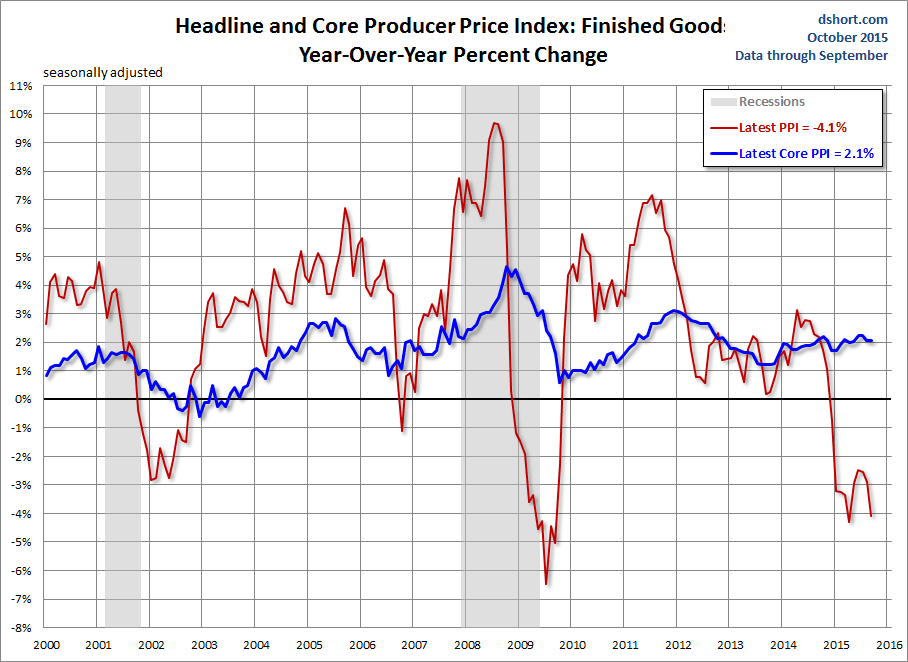Producer Price Index: Ninth Consecutive Month Of YoY Decline
Doug Short | Oct 15, 2015 12:24AM ET
Today's release of the September Producer Price Index (PPI) for Final Demand came in at -0.5% month-over-month seasonally adjusted, down from 0.0% in August. It is down -1.1% year-over-year, the ninth consecutive month of YoY shrinkage. Core Final Demand (less food and energy) came in at -0.3% MoM, down from 0.3% the previous month and is up 0.8% YoY. The Investing.com forecasts were for -0.2% headline and 0.1% core.
Here is the summary of the news release on Finished Goods:
The Producer Price Index for final demand declined 0.5 percent in September, seasonally adjusted, the U.S. Bureau of Labor Statistics reported today. Final demand prices were unchanged in August and rose 0.2 percent in July. On an unadjusted basis, the final demand index fell 1.1 percent for the 12 months ended in September, the eighth straight 12-month decline....
In September, two-thirds of the decrease in the final demand index is attributable to prices for final demand goods, which fell 1.2 percent. The index for final demand services moved down 0.4 percent. More…
Finished Goods: Headline and Core
The BLS shifted its focus to its new "Final Demand" series in 2014, a shift we fully support. However, the data for these series are only constructed back to November 2009 for Headline and April 2010 for Core. Since our focus is on longer term trends, we continue to track the legacy Producer Price Index for Finished Goods, which the BLS also includes in their monthly updates.
The Headline Finished Goods for September came in at -1.3% MoM and is down -4.1% YoY. Core Finished Goods were up 0.2% MoM and up 2.1% YoY.
Now lets visualize the numbers with an overlay of the Headline and Core (ex food and energy) PPI for finished goods since 2000, seasonally adjusted. The plunge since mid-2014 in headline PPI is, of course, energy related -- now off its interim low set in April. Core PPI has remained relatively stable since early 2014.

As the next chart shows, the Core Producer Price Index is far more volatile than the Core Consumer Price Index. For example, during the last recession producers were unable to pass cost increases to the consumer.

Check back next month for a new update.
Trading in financial instruments and/or cryptocurrencies involves high risks including the risk of losing some, or all, of your investment amount, and may not be suitable for all investors. Prices of cryptocurrencies are extremely volatile and may be affected by external factors such as financial, regulatory or political events. Trading on margin increases the financial risks.
Before deciding to trade in financial instrument or cryptocurrencies you should be fully informed of the risks and costs associated with trading the financial markets, carefully consider your investment objectives, level of experience, and risk appetite, and seek professional advice where needed.
Fusion Media would like to remind you that the data contained in this website is not necessarily real-time nor accurate. The data and prices on the website are not necessarily provided by any market or exchange, but may be provided by market makers, and so prices may not be accurate and may differ from the actual price at any given market, meaning prices are indicative and not appropriate for trading purposes. Fusion Media and any provider of the data contained in this website will not accept liability for any loss or damage as a result of your trading, or your reliance on the information contained within this website.
It is prohibited to use, store, reproduce, display, modify, transmit or distribute the data contained in this website without the explicit prior written permission of Fusion Media and/or the data provider. All intellectual property rights are reserved by the providers and/or the exchange providing the data contained in this website.
Fusion Media may be compensated by the advertisers that appear on the website, based on your interaction with the advertisements or advertisers.